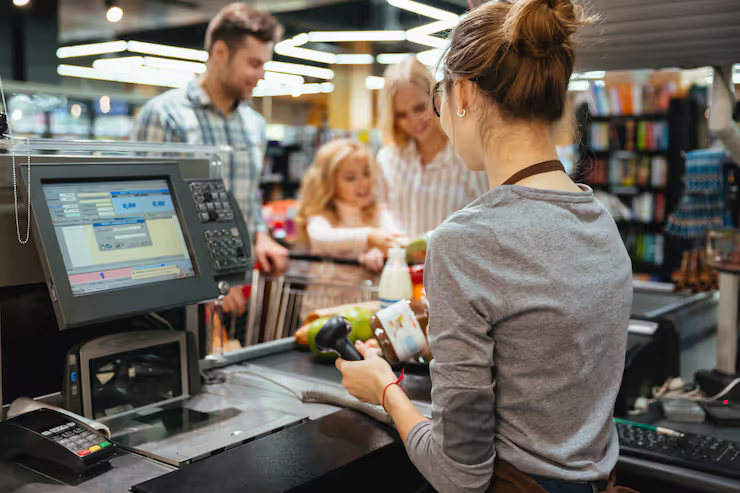Restaurant POS Software Explained: Benefits, Trends, Tools & Compliance
Restaurant POS (Point of Sale) software is a digital system used by food service businesses to manage orders, process payments, track inventory, and generate reports. It replaces traditional cash registers and paper-based order systems, streamlining front-of-house and back-of-house operations
With rising customer expectations, contactless payments, online food ordering, and inventory management challenges, restaurants need systems that simplify operations and reduce errors.

Why POS systems are critical in the food industry:
-
Order accuracy: Reduces mistakes by sending orders directly to the kitchen.
-
Inventory tracking: Alerts staff about low stock or waste.
-
Faster checkouts: Speeds up transactions through multiple payment options (card, wallet, UPI, QR, etc.).
-
Data insights: Tracks peak hours, best-selling dishes, customer preferences, and employee performance.
-
Remote management: Cloud-based POS tools let owners manage outlets across multiple locations.
Who uses POS software:
-
Full-service restaurants
-
Cafés and bakeries
-
Food trucks and kiosks
-
Fast food chains
-
Cloud kitchens and delivery-only restaurants
-
Hotel restaurants and bars
Recent Updates – Trends and innovations in restaurant POS (2024–2025)
The past year has brought notable updates in how restaurant POS systems function, with a focus on cloud technology, AI, and seamless integrations.
| Trend | Details |
|---|---|
| Cloud-first POS platforms | More restaurants adopt cloud-based systems for real-time updates and mobility. |
| AI-powered analytics | POS software now includes predictive analytics for staffing, menu planning, and waste control. |
| QR code ordering and payment | Self-service ordering through QR codes is widely implemented post-pandemic. |
| POS + delivery app integration | POS systems directly sync with platforms like Swiggy, Zomato, DoorDash, etc. |
| Multi-language support | To serve diverse customers and staff, POS software now supports regional languages. |
Examples of 2024 developments:
-
Toast POS (US) rolled out an AI-based inventory predictor in April 2024.
-
Petpooja (India) added cloud-KDS and WhatsApp ordering support in August 2024.
-
Square for Restaurants launched deeper Shopify and Uber Eats integration in late 2024.
Laws or Policies – Compliance and regulations affecting restaurant POS
Restaurant POS systems must comply with national and local tax, billing, and data privacy regulations. Many countries require digital billing systems to be GST/VAT compliant and securely store transaction data.
Regulatory highlights for POS systems in India (example):
| Requirement | Explanation |
|---|---|
| GST-compliant invoicing | POS must generate bills with proper GST breakup and HSN codes. |
| FSSAI compliance | Some POS tools now offer FSSAI tracking for hygiene audits. |
| Digital payment support | Must accept UPI, cards, and wallets in accordance with RBI digital payment push. |
| Data protection (DPDP Act 2023) | Customer and transaction data must be securely stored and accessed. |
Tools and Resources – Top restaurant POS software and helpful solutions
Here’s a list of well-known restaurant POS software and tools that support modern features and compliance needs:
| Tool Name | Best For | Key Features |
|---|---|---|
| Petpooja (India) | Cafes and mid-sized restaurants | KOT, inventory, CRM, third-party integrations |
| Toast POS (USA) | Full-service restaurants | Online ordering, payroll, analytics, multi-location support |
| Square for Restaurants | Food trucks, new outlets | Cloud-based, mobile POS, custom menus, card reader |
| Revel Systems | Large chains and franchises | Customizable workflows, loyalty programs, CRM |
| Lightspeed POS | Fine dining and global restaurants | Real-time inventory, menu management, offline mode |
| POSist | Enterprise food outlets in India | Central kitchen management, multi-brand dashboards |
| Zoho Restaurant POS | Small restaurants | Cloud POS, menu builder, remote monitoring |
Helpful resources:
-
POS cost calculators – Compare pricing models (monthly/yearly, hardware bundles)
-
Free billing templates – For small businesses not using automated POS
-
GST e-invoicing compliance tools – Ensure POS software is GST-ready
-
Staff scheduling software integrations – Align POS with employee shifts
-
Online ordering API kits – For restaurants building custom ordering systems
FAQs – Common questions about restaurant POS systems
Q1: What’s the difference between a regular POS and a restaurant POS system?
A restaurant POS includes features tailored for food service — like kitchen display systems (KDS), split billing, table management, and integration with food delivery platforms — which general POS systems usually lack.
Q2: Is cloud-based POS better than traditional offline POS?
Cloud-based POS systems offer real-time syncing, remote access, automatic updates, and data backup, making them more flexible. However, some small restaurants may prefer offline POS due to lower costs or unstable internet.
Q3: Can a restaurant POS work on tablets or smartphones?
Yes. Many modern POS systems work on Android or iOS devices, letting staff take orders directly from the table or on the go. Some apps also support kitchen receipts via Bluetooth printers.
Q4: How much does restaurant POS software cost?
Costs vary depending on features and scale. Entry-level cloud POS solutions may start around $15/month, while enterprise-level tools with hardware bundles can cost hundreds per month.
Q5: Can POS systems integrate with food delivery apps?
Yes. Many POS platforms offer direct integrations with platforms like Zomato, Uber Eats, DoorDash, etc., to streamline orders and avoid manual entry.
Final Thoughts
Restaurant POS software has become a necessity in modern food service, not just for billing but for managing inventory, improving efficiency, supporting digital payments, and offering better customer service.
As the restaurant industry continues to evolve post-pandemic, the right POS system can help adapt to changing consumer habits, stay compliant with laws, and manage multiple sales channels — from dine-in to delivery. By understanding the tools, trends, and rules, food business owners can make smart decisions for smoother daily operations.
